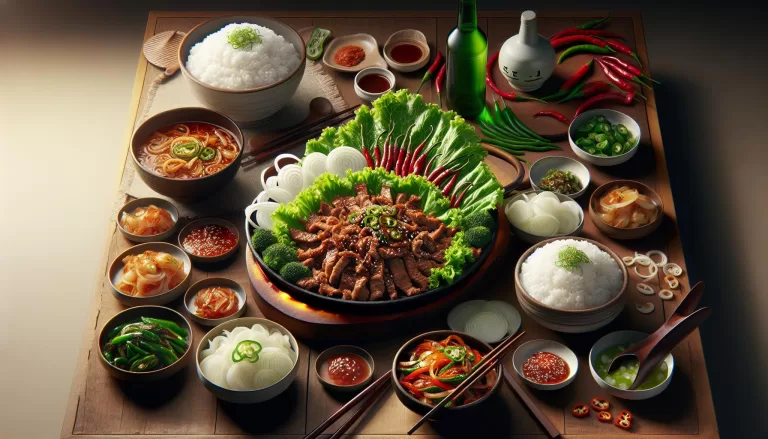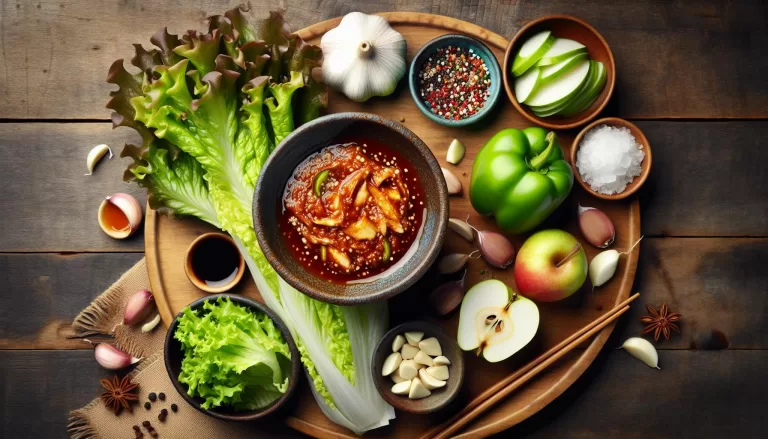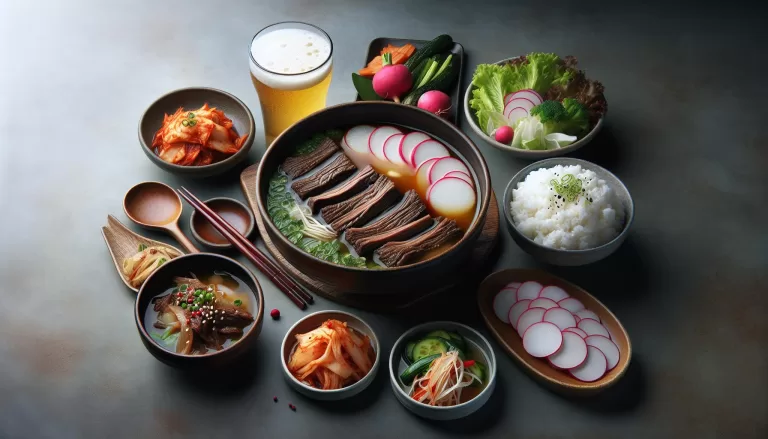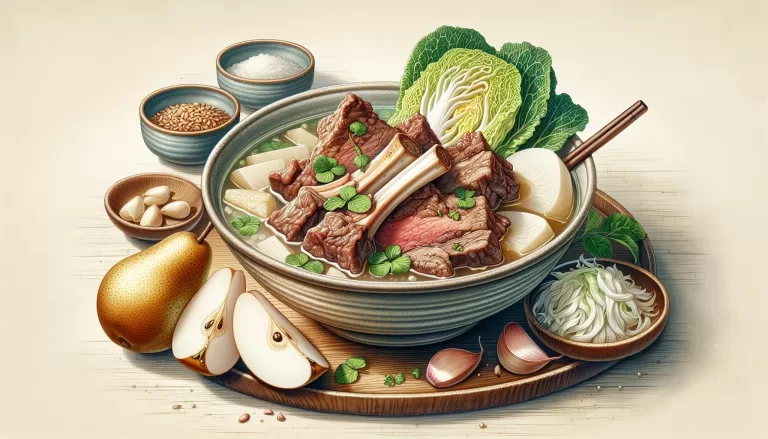Mastering Jeyuk Bokkeum: Easy Homemade Korean Spicy Pork Recipe Guide
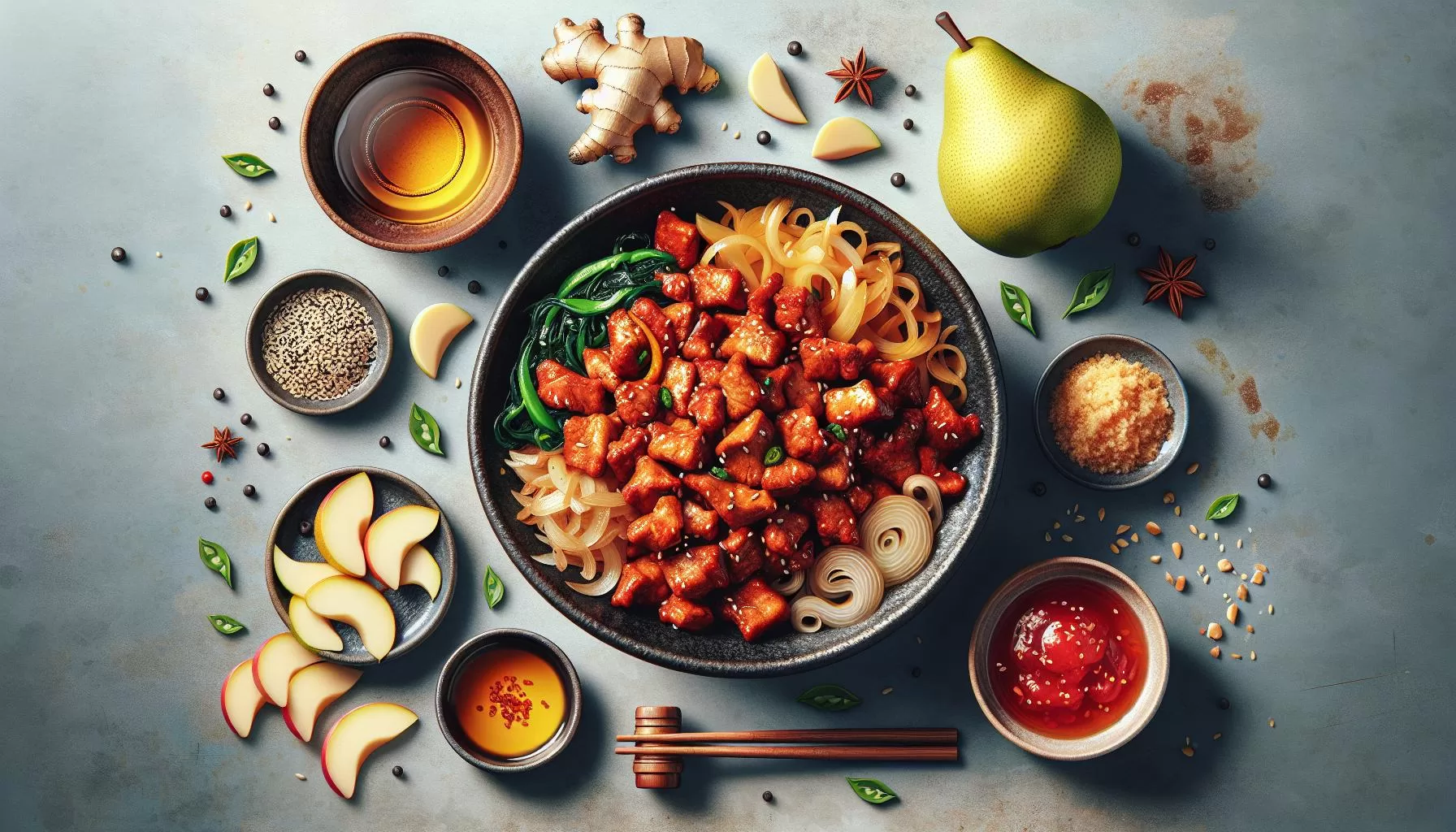
Ingredients for Homemade Korean Spicy Pork Jeyuk Bokkeum
Time to grab all the essentials you’ll need to whip up this mouthwatering dish at home. Your shopping list should include:
- 1 pound of pork belly, thinly sliced
- 2 cups of ripe kimchi
- 1 green bell pepper
- 1 red bell pepper
- 1 large onion
- 1 teaspoon of white sugar
- 1 tablespoon of cooking oil
For the exciting spicy marinade, here’s what you’ll require:
- 4 tablespoons of Korean red chili paste (Gochujang)
- 2 tablespoons of red chili flakes (Gochugaru)
- 2 tablespoons of soy sauce
- 2 tablespoons of rice wine
- 1 tablespoon of minced garlic
- 1 tablespoon of finely grated ginger
- 2 tablespoons of brown sugar
Nutritional wise, Jeyuk Bokkeum leans towards the healthier side. Here’s some handy information:
| Nutrient | Quantity (per serving) |
|---|---|
| Calories | 400 kcal |
| Carbs | 20g |
| Proteins | 30g |
| Fat | 20g |
Let’s focus on some particularities with the ingredients. Indeed, the pork belly stands paramount – the fattier, the better. Here in Korea, fat’s not seen as a foe but a friend. It’s the very thing imbuing the dish with such succulence!
Then, the spices take center stage, giving Jeyuk Bokkeum its distinctive fiery imprint. You might feel tempted to reach for regular red pepper flakes, but don’t do it! You must stick with Korean chili flakes (Gochugaru) if you’re aiming for that authentic flavor.
That being unique, don’t fret if you can’t find Gochujang anywhere near your local grocery store. Substituting it with Sriracha or any other hot-spicy sauce will still get you a kickin’ Jeyuk Bokkeum. But bear in mind, it’ll be slightly different from the classic Korean taste.
Ultimately it’s about having fun! Explore, play around with ingredients, bring your spin to the mix. It’s these little tweaks that make cooking such a thrill and your Jeyuk Bokkeum uniquely yours.
Step-by-Step Instructions for Making Jeyuk Bokkeum
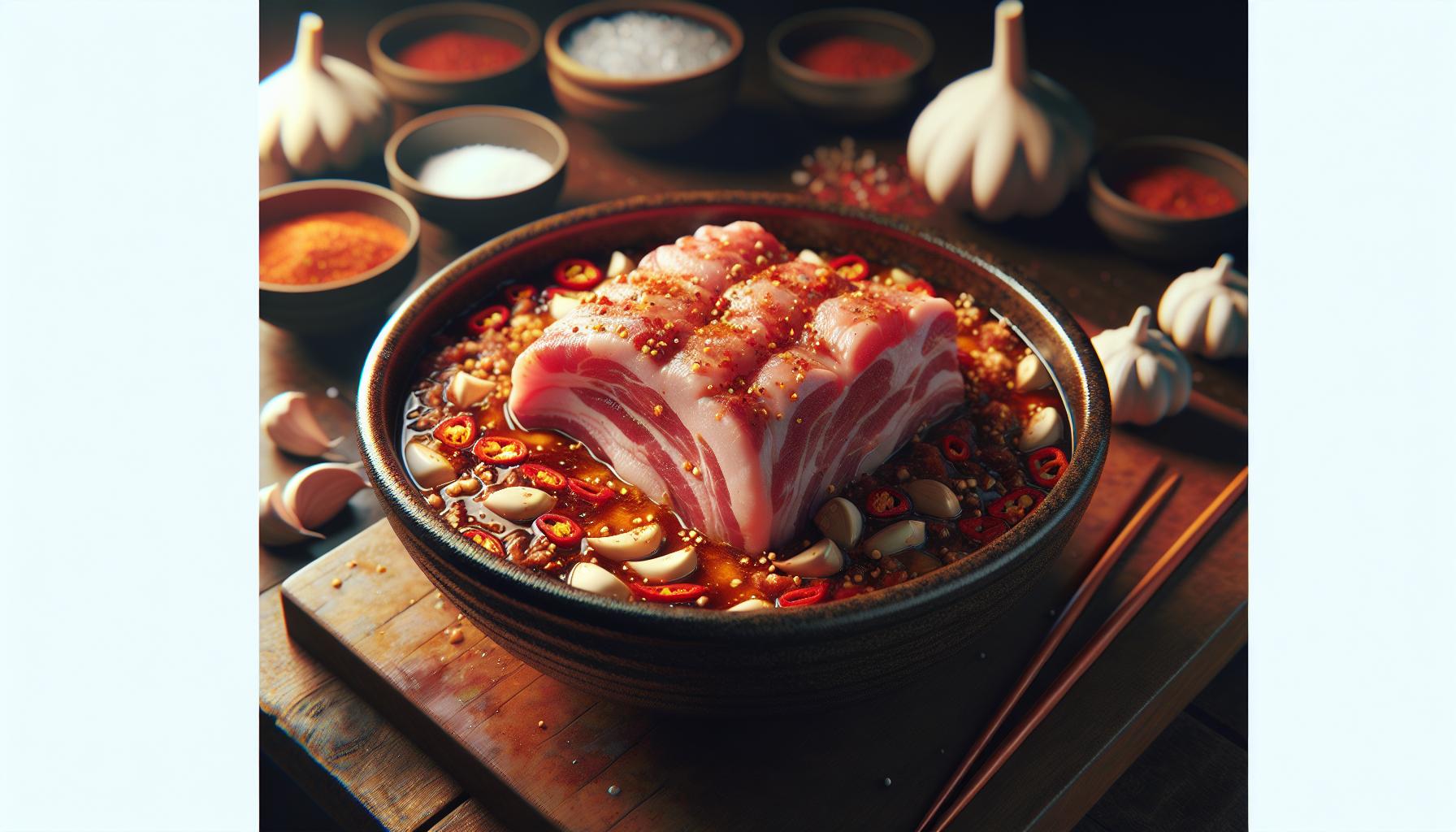
Now that you’ve assembled all your ingredients, it’s time to dive into the cooking process.
Step 1: Start off by marinating your pork belly. Combine the pork, garlic, ginger, soy sauce, sugar, and Korean chili flakes in a bowl. Allow this to rest for at least 30 minutes – if you can spare an hour or two, even better! This is the first step in allowing the flavors to truly meld together.
Step 2: Crank your wok up to high heat. Ensure it’s truly smokin’ before you add your meat. This will give you that irresistible char and sear on the pork.
Step 3: Once browned, set the pork aside. Add your veggies into that same wok. Let the onions soften and the peppers get some color.
Step 4: Return the meat to the pan, stir in the gochujang and mirin. Cook for a few more minutes until everything’s heated through.
Here’s where you can truly make it your own. Want to give the dish an extra kick? Use extra chili flakes. If you’re a garlic fiend, add another clove or two. The joy of cooking Jeyuk Bokkeum is in the adaptation and the process of making the dish uniquely yours.
Note: We’ll also mention a couple of nutrition facts about this dish for those who are interested.
| Nutrition Category | Amount per Serving |
|---|---|
| Calories | 350 |
| Carbs | 15g |
| Protein | 25g |
| Fat | 20g |
| Vitamins | A, B variants, K |
Keep these facts in mind as you cook. You’re not just creating a delicious meal, you’re fueling your body in a nourishing, flavorful way.
Tips for Achieving the Perfect Balance of Flavors
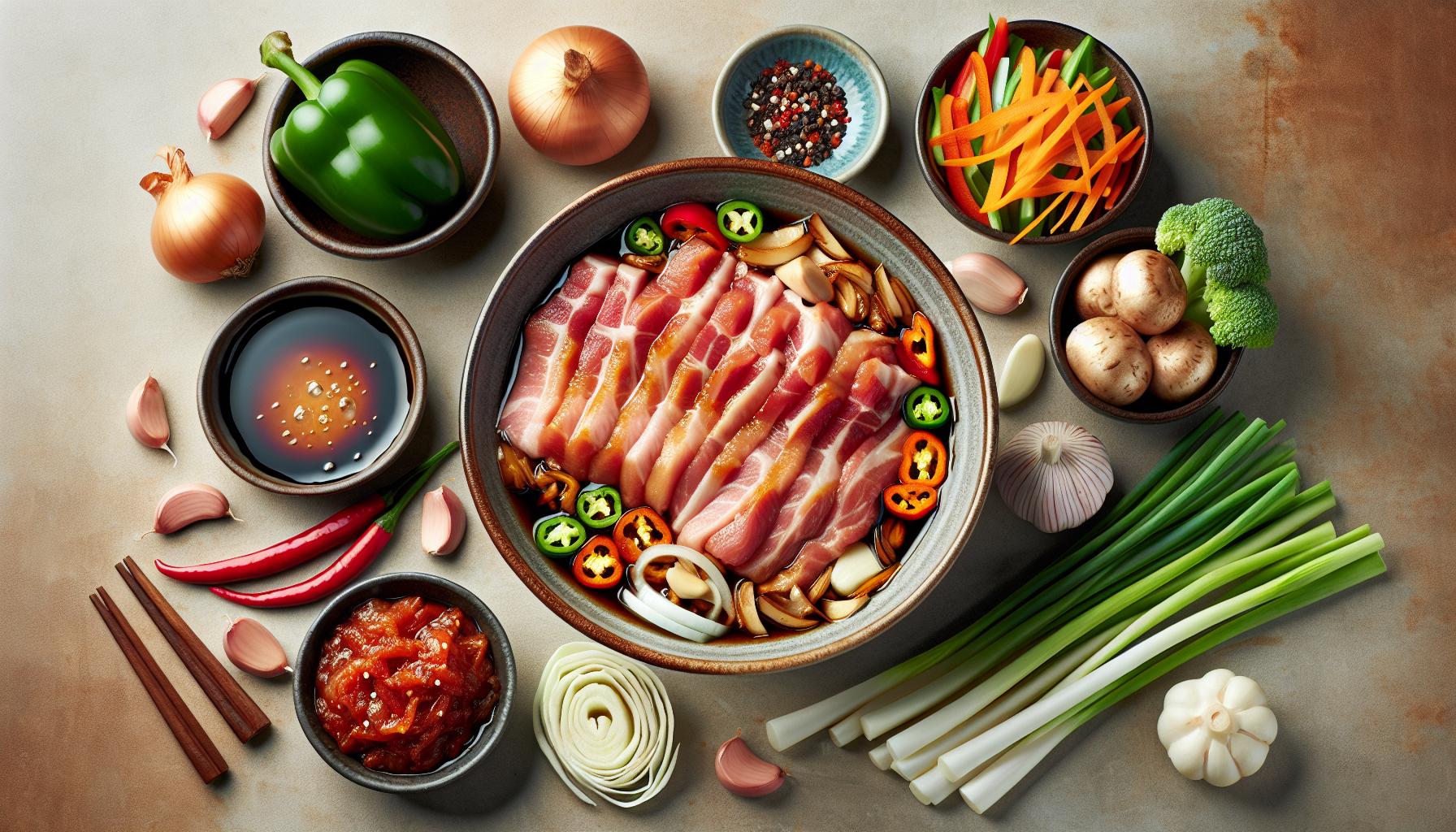
When it comes to Korean cuisine, balance is key. It’s not just about maximizing the heat but also about achieving that sweet spot between different flavors. Let’s dive into some tips to help you hit that note of perfection with your Jeyuk Bokkeum.
Marination Magic
Firstly, don’t rush the marination process. It’s easy to underestimate the importance of marinating your pork belly, but the truth is, this step can elevate your dish to wow-worthy levels. Infuse your meat with flavors of soy, sesame, garlic, and ginger. Let these aromatics break down the fats and tenderize your protein. The longer you marinate, the deeper and richer the flavors become.
Managing the Heat
Next up: managing the spice. The star ingredient of Jeyuk Bokkeum is undoubtedly Gochujang — the vibrant, fiery, and somewhat sweet chili paste. Not everyone has the same tolerance for heat, so adjust the amount of Gochujang to suit your preference. But remember, you’re aiming for a balance. Too much can overpower the other delicate flavors. Too little, and it loses its identity.
Vegetable Varieties
Onto the veggies. Yes, green onions and cabbage are classic for Jeyuk Bokkeum, but feel free to get creative. Don’t be afraid to add in some thinly sliced carrots, sweet bell peppers, or hearty shiitake mushrooms. They not only add color and texture to your dish but also can complement and counterpoint the spice of the Gochujang.
Swap in some Secrets
Finally, don’t hesitate to shake things up! Try adding a dash of Mirin — a type of sweet rice wine that’s a common secret weapon in Korean cooking. It can provide a subtle sweetness that mellows out the heat and enhances other flavors. Or, consider swapping out regular sugar for a sweeter natural alternative such as honey.
Remember, cooking is an art. It’s all about finding your unique palate that makes a recipe yours. Play around with these tips and you’ll soon find your perfect balance for Jeyuk Bokkeum.
Serving Suggestions and Pairings

Pairing the Jeyuk Bokkeum with the right foods not only completes your meal but also elevates the flavor of the dishes.
Typically, a classic side for this spicy pork dish is a bowl of warm, steamed rice. It helps balance the strong and fiery notes of the pork.
Kimchi is another integral part of a classic Korean meal. Its tangy crunch provides a refreshing contrast to the meat. Remember, the older your kimchi, the more robust the flavor.
You may also serve your Jeyuk Bokkeum with Korean sides or banchan. Common favorites include:
- Oi Muchim (Spicy cucumber salad)
- Namul (Seasoned spinach)
For a different twist, try replacing traditional rice with Korean cold noodles or Naengmyeon. The cool, chewy noodles could offer a surprising and tasty contrast to the hearty pork.
Another great pairing is Soju, a popular Korean alcohol. Its clean, neat taste makes it the perfect foil for the bold, spicy flavors of Jeyuk Bokkeum. However, if you’re not into spirits, Korean barley tea or Boricha could be a nice non-alcoholic alternative.
Don’t be afraid to mix and match these suggestions or experiment with your own. Part of the joy of cooking is discovering your unique preferences and style. Whether you’re crafting a midweek dinner or a feast for friends, these pairings will help you create a rounded, satisfying Korean meal. Now, let’s move on to the next section where we delve into some nutritious facts about our Jeyuk Bokkeum.
Frequently Asked Questions (FAQs) About Jeyuk Bokkeum

Q: What are some unique ingredients you can add to Jeyuk Bokkeum for an extra kick?
- A: It’s all about playing around with your taste buds. Try adding fresh ginger, or a splash of sesame oil for extra depth. If you’re a fan of sweetness, a drizzle of honey makes for a memorable finish.
Q: What’s the nutritional value of Jeyuk Bokkeum?
- A: If health and nutrition are on your radar, you’re in luck. Jeyuk Bokkeum, depending on your preparation and portions, can be a rich source of protein and have moderate carbs. To be specific, here’s an indicative table:
| Nutrient | Value (per serving) |
|---|---|
| Calories | 489 kcal |
| Carbs | 22g |
| Protein | 28g |
| Fat | 29g |
Remember, these values can vary based on your specific ingredients and serving sizes.
- A: Homemade recipe always thrives on personal touch. You might want to replace Gochujang (Korean chili paste) with Ssamjang (mixed paste) for a milder taste. And about that secret ingredient? Try a spoon of Korean pear juice. Trust us, it works like magic!
Let’s dive into the intricacies of preparing this mouthwatering dish in the next segment: “Step-by-Step Guide to Making Jeyuk Bokkeum”. Here, we’ll give you the lowdown on every detail you need to master the recipe.
Conclusion
So, you’ve got the scoop on how to whip up a mouthwatering Jeyuk Bokkeum right in your kitchen. With our unique twist of ingredients like fresh ginger, sesame oil, and honey, you’ll be serving up a dish that’s not just tasty but also packed with protein and just the right amount of carbs. Remember, it’s all about making it your own. Switch up the Gochujang with Ssamjang or add a splash of Korean pear juice for that special touch. Now, armed with our step-by-step guide, you’re ready to master this homemade Korean spicy pork recipe. Get ready to impress your friends and family with your culinary skills!
